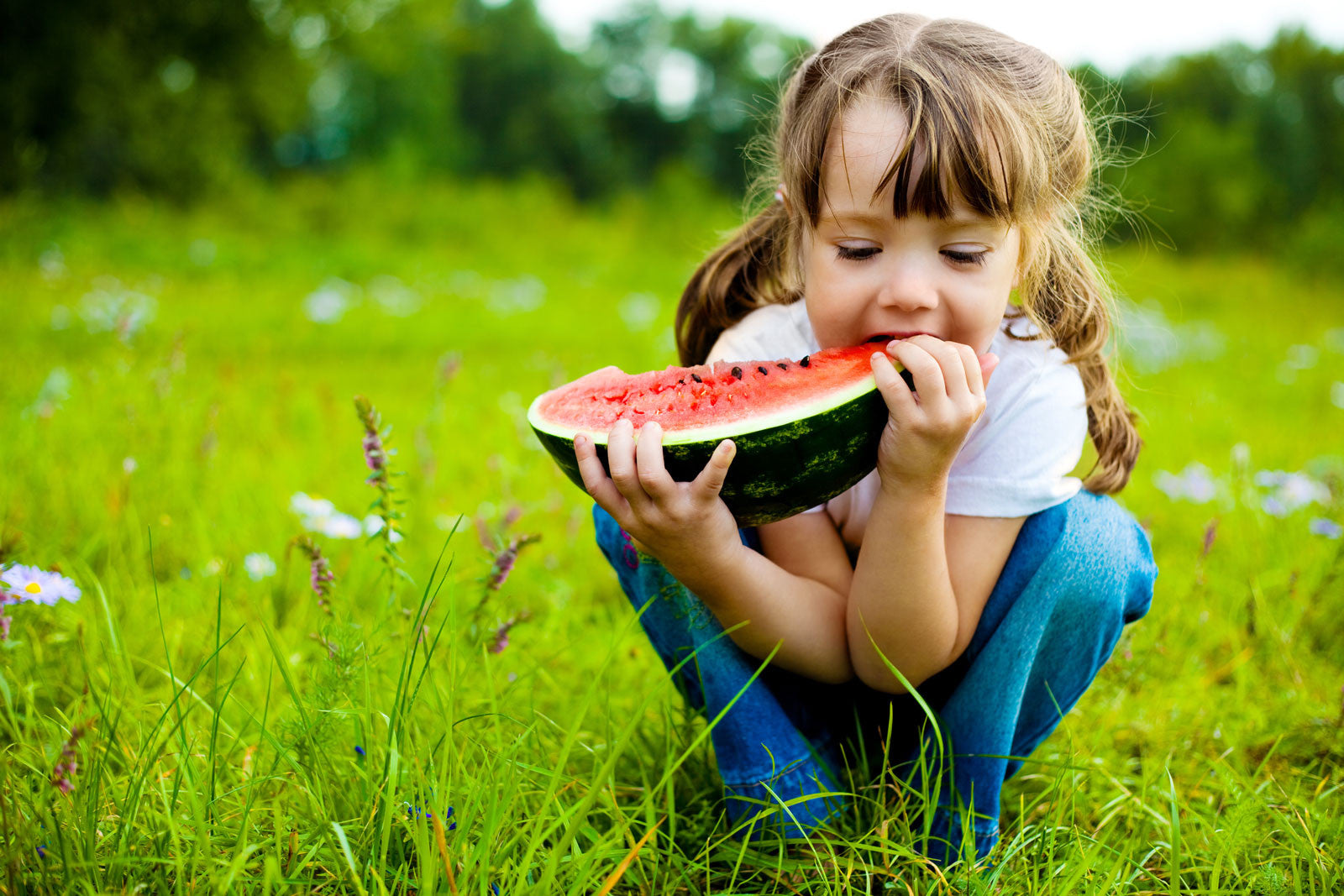10 Ways to Get Kids to Eat Healthier

An excerpt from Lunch Lessons: Changing the Way We Feed Our Children by Ann Cooper and Lisa M. Holmes
Eating habits are learned behaviors; they’re not intuitive. So what your children learn to eat at home early in life sticks with them well into adulthood.
Today we are disconnected from our food sources in a way that is unprecedented in human history. Fewer and fewer Americans cook meals from scratch because it’s easier and faster to throw a frozen dinner in the oven or grab something from a fast-food restaurant on the way home from work. And the guerilla marketing foisted upon us by fast- and processed-food companies isn’t helping.
Most parents know that their kids are under continuous assault by corporate food advertising — but they feel frustrated by it, and even powerless against it.
In reality, a few simple tools combined with a mantra of “variety, moderation, and balance” will provide you with all you need to ensure the long-term nutritional health of your child.
1. Be a good role model.
Most of the parents we know complain that their children refuse to eat healthfully and come to us in search of magic recipes that will put an end to mealtime madness. The real problem most often lies with the parents, not the kids.
Most of us are so accustomed to eating out and buying prepared foods in the grocery store that we don’t even know what good food is anymore. We can’t line our cabinets with packaged cereals and sodas and expect our kids to eat like they were raised on a commune in rural Vermont. In order to be good role models we must educate ourselves first and then practice what we preach.
2. Take your kids shopping with you.
Unfortunately we don’t all live near farms or farmers’ markets, so it’s not easy for us or our children to feel a connection with good, whole (unprocessed) foods. One way to help them learn is to make a point to take them grocery shopping with you. Of course it’s probably easier to go alone when there’s someone at home to watch them or they’re at school, but it’s important for them to see foods in their raw states so they can explore and ask questions.
Take them when you’re not in a hurry and spend a lot of time in the aisles that contain unprocessed foods — the produce, meat, and fish departments, for example. If your child appears to be interested in a certain type of fruit or vegetable, encourage him or her to explore that item; don’t just assume that your child won’t like it. Take it home and let him try it so he can make his own decisions.
When Ben, Lisa’s son, was a baby, he liked to ride in the cart holding an avocado. Every time they went shopping he’d point at the avocados until Lisa gave him one. When he was three he asked if he could bring some mangos home. He was also intrigued by the spiky orange exterior of the unusual kiwano fruit (also known as the African Horned Melon). He carried it for the duration of their shopping trip and insisted it be cut the minute he got it home. Its green, seedy interior was a bit off-putting to him, but he tried it anyway.
Exploring food this way gives Ben and his mom a chance to talk about how something is cooked and where it comes from. It also allows Ben to feel like he’s making choices about what he eats.
3. Be flexible!
Remember, anything in moderation is okay. Of course, if you eat doughnuts in moderation, followed by potato chips in moderation and soda in moderation, it is no longer healthy. Having a cookie every day and balancing it with healthy foods is a better practice of moderation.
While we always want to make the healthiest choices for our children’s bodies, a special treat once a week or even once a day won’t do any damage. On the contrary, it will help make eating a more enjoyable experience and will help your child build a good relationship with food.
4. Make mealtime special.
There are all sorts of fun things we can do to make mealtime special. First and foremost, sit down and enjoy your food. Take time to savor flavors. Children should never eat while walking around.
We understand that some young children have difficulty sitting for the entire meal. In those cases we recommend allowing the child to get up once or twice, while encouraging the child to sit — not stand — at the table when he or she comes back to eat. For children who are able to understand, explain to them that mealtimes are special family times and it is important to the family that everyone sit down to eat and talk together.
Make a ritual out of dinner and give everyone a special task — maybe even let each child have one night a week to plan and help make dinner. Have the kids set the table. Cloth napkins and real glasses set a more formal tone and are better for the environment. Candles aren’t just for adult dining — they can set a calming tone for the meal and will show kids that mealtime is special. Make a point not to allow mealtimes to degenerate into family argument time.
5. Don’t be a short-order cook.
Ever find yourself making one meal for the adults in the house and another for the kids — or even one for each kid? Children take their time warming up to new things and if you keep giving them the old standbys they’re not going to branch out and explore new foods. Be patient.
Most research says that it takes an average of ten to twelve attempts before a child will try a new food, unless they are involved in cooking and gardening projects like Alice Waters’s Edible Schoolyard or after school summer programs. Learning about food and cooking in an active way helps breed a sense of culinary adventure.
Make the same dinner for everyone in the family while making sure to put some foods on the plate that your children like — then add something new. If they don’t touch it, don’t worry about it, and definitely don’t make an argument out of it.
Try again the next week and again the following week. Eventually they’ll surprise you by at least tasting that new food.
6. Don’t buy into marketing for kids.
Kids don’t need frozen chicken nuggets, French fries, macaroni and cheese, and pizza to keep them happy. Highly processed foods like these are loaded with chemicals, synthetic fats, additives, artificial sweeteners, and food colorings. And even a three-year-old can grasp why sodas aren’t good for you and why we don’t eat foods with lots of fat every day at every meal.
Since television ads are the most prevalent medium and therefore influential, we recommend limiting television viewing early in life to channels with fewer commercials — or better yet, to videos with no commercials. Use a digital video recorder to record special programs on television so you can edit out the commercials as they watch.
You can't keep heavily processed foods out of their diets forever, but the longer you limit exposure while instilling healthy eating habits, the more likely your children will be to make better choices when left to their own devices.
Parents should also be working to remove food colorings, benzoate preservatives, and artificial sweeteners from their children’s diets. More than 2.5 million children have been diagnosed with Attention Deficit Hyperactivity Disorder (ADHD) and an additional 15 percent of children have borderline hyperactivity or behavioral issues. During our research we discovered nearly 100 studies validating the hypothesis that food dyes and additives are a factor in attention and behavior disorders and can increase the incidence of ADHD. In one of those studies 73 percent of children placed on a diet free from chemical additives, dyes, and artificial sweeteners showed a reduction in hyperactivity and an increase in attention.
Faced with the child who thinks he might implode without that blue applesauce, hold your ground and look for an organic applesauce instead while explaining that both taste the same but one has things added to it that aren’t healthful. If you have a particularly stubborn child, do a blind taste test to prove your point.
7. Don’t use food as rewards, bribes, or punishments.
Okay, okay, we know, M&Ms have a long history as the greatest bribe candy on Earth for potty training — even the most health-conscious mom will break down and try M&Ms during that oh-so-critical stage of development. Don’t give in! Stickers work just as well and you won’t be setting a precedent for using food as a bribe or reward as your child gets older.
Sure, it’s okay to take the kids out for ice cream or frozen yogurt after a good (or even a bad) soccer game, just don’t use it as an incentive for a good game. On the flip side, don’t punish children for not eating certain foods — it will only foster a negative relationship between you and your children, not to mention your children and food.
8. Let kids help in the kitchen.
Encourage your children to help out in the kitchen. Even a two-year old can help peel potatoes or carrots. For smaller children, invest in a stool that allows your children to safely reach the kitchen counter so they can see what you’re doing. Or if you have room, set up a workstation at your child’s height so he can participate without having to stand on tiptoes.
If a child is interested in doing more in the kitchen, don’t automatically assume that she can’t or that the task will be too dangerous. Know your child’s limits and help him achieve success by providing support and encouragement in a safe setting.
Kids love eating food they create. Involve your child in cooking or snack preparation and they will be more likely to eat new foods, including fruits and vegetables.
9. Love and accept your child no matter what!
Love and accept your child at any weight, size, or shape. During childhood, growth is unpredictable at best. It comes in spurts and a once-skinny child can suddenly plump up while his height catches up with his weight. There’s a lot of pressure in our society to be thin, and you might be tempted to put your child on a diet during a growth spurt, but that
won’t be helpful and may even cause emotional and physical damage.
Instead, help your child maintain his weight until his height catches up. The best way to do that is to teach good healthy eating habits and encourage your child to be active; try yoga DVDs for kids and emphasize activities that keep you all moving and create healthy outlets for all that kid energy.
10. Make sure your child eats breakfast.
It’s the most important meal of the day, and it should ideally be the largest meal of the day to get your child off on the right foot. After ten to twelve hours with no food it’s important to refuel the engines. If they don’t eat in the morning they’ll be tired and unable to concentrate in school before lunch. It’s essential that children jumpstart their metabolism in the morning so their bodies don’t enter starvation mode, which might later cause them to experience difficulty maintaining a healthy body weight.
Some children need to practice eating breakfast. We recommend starting small and working to a bigger meal if you’re having trouble getting your child to eat breakfast. For most children, breakfast should be around 500 calories and should be nutritionally balanced.
Starting kids off with sugar first thing in morning is not ideal. This gives a quick burst of energy and then leaves your child drained. Breakfast should always include a source of protein, some healthy fats, carbohydrates (whole grains are best), and vitamins and minerals.
Also in Blog

Body Peace & Personal Empowerment

Yoga for Swimmers: Poses for Strength and Mobility

